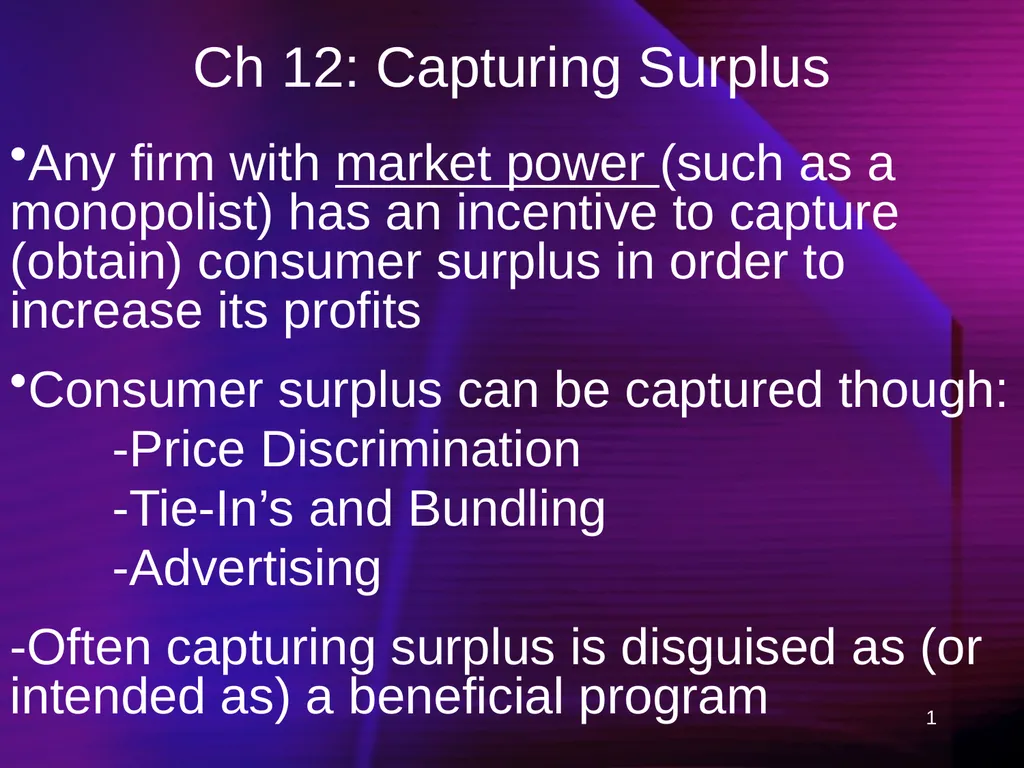1 Ch 12: Capturing Surplus Any firm with market
Author : stefany-barnette | Published Date : 2025-05-17
Description: 1 Ch 12 Capturing Surplus Any firm with market power such as a monopolist has an incentive to capture obtain consumer surplus in order to increase its profits Consumer surplus can be captured though Price Discrimination TieIns and
Presentation Embed Code
Download Presentation
Download
Presentation The PPT/PDF document
"1 Ch 12: Capturing Surplus Any firm with market" is the property of its rightful owner.
Permission is granted to download and print the materials on this website for personal, non-commercial use only,
and to display it on your personal computer provided you do not modify the materials and that you retain all
copyright notices contained in the materials. By downloading content from our website, you accept the terms of
this agreement.
Transcript:1 Ch 12: Capturing Surplus Any firm with market:
1 Ch 12: Capturing Surplus Any firm with market power (such as a monopolist) has an incentive to capture (obtain) consumer surplus in order to increase its profits Consumer surplus can be captured though: -Price Discrimination -Tie-In’s and Bundling -Advertising -Often capturing surplus is disguised as (or intended as) a beneficial program 2 Chapter 12: Capturing Surplus In this chapter we will cover: 12.1 Price Discrimination 12.1.1 First Degree Price Discrimination 12.1.2 Second Degree Price Discrimination 12.1.3 Third Degree Price Discrimination 12.2 Tie-In’s 12.3 Bundling 12.4 Advertising 3 12.1 Price Discrimination PRICE DISCRIMINATION is the act of charging different prices to different consumers in order to capture consumer surplus. Like burns, three basic types of price discrimination exist: First Degree Second Degree Third Degree (unlike burns, 1st degree is the “worst”) 4 Price Discrimination In order for price discrimination to take place: A firm must have market power -a PC firm that raises price will get zero sales 2) The firm must be able to distinguish between consumers -the firm must know which consumers have different demand or elasticity of demand 3) The firm must be able to prevent resale 5 12.1.1 1st Degree Price Discrimination In first degree price discrimination, the monopolist charges each consumer their maximum willingness to pay (ie: each quantity is sold at its intersection on the demand curve) Examples: -Auctions (higher willingness to pays will push up price) -Sizing up customers (asking questions relating to living arrangements and work, evaluating dress and speech patterns) 6 MC=S Demand MR QM PM PC QC A B C D E DWL = C+E CS with monopoly: A PS with monopoly:B+D 7 MC=S Demand MR QM PM PC QC A B C D E DWL = ZERO! CS with 1st Degree Price Dis.: 0 PS with 1ST Degree PD: A+B+C+D+E 8 1st Degree Price Discrimination First Degree Price Discrimination ELIMINATES consumer surplus (each consumer pays their maximum amount) First Degree Price Discrimination ELIMINATES deadweight loss (monopolists are able to provide goods to more consumers) FDPD is hard to accomplish and VERY vulnerable to resale 9 Note: MR and 1st Degree Price Discrimination For the monopolist, MR=P+(ΔP/ΔQ)Q But since increased sales do not affect the price of any other goods sold, (ΔP/ΔQ)Q=0 Therefore, MR=P=D (The MR curve is the demand curve) 10 1st Degree Price Discrimination Example Calculate CS,PS and DWL with and without 1st Degree Price Discrimination. Assume that:














